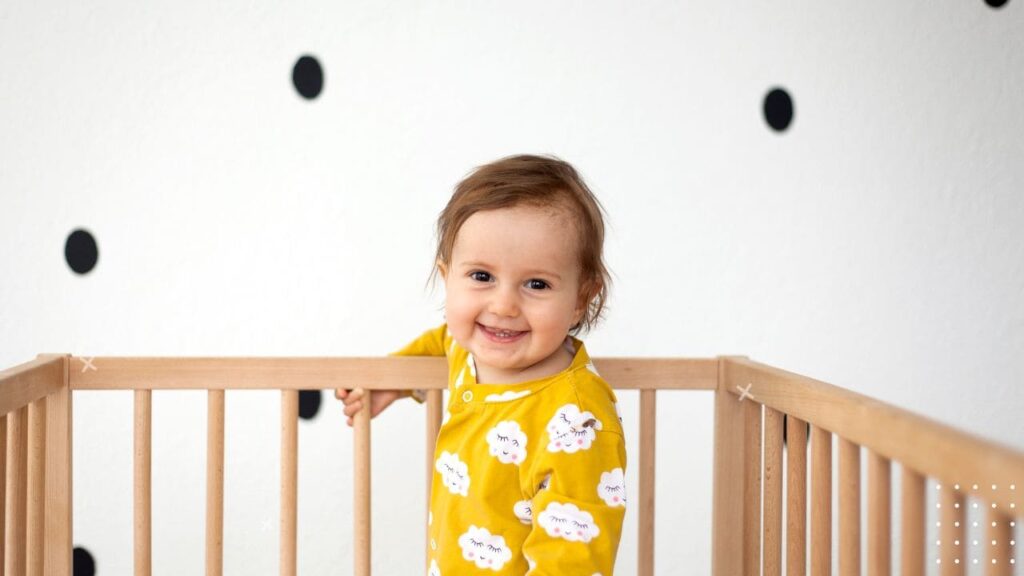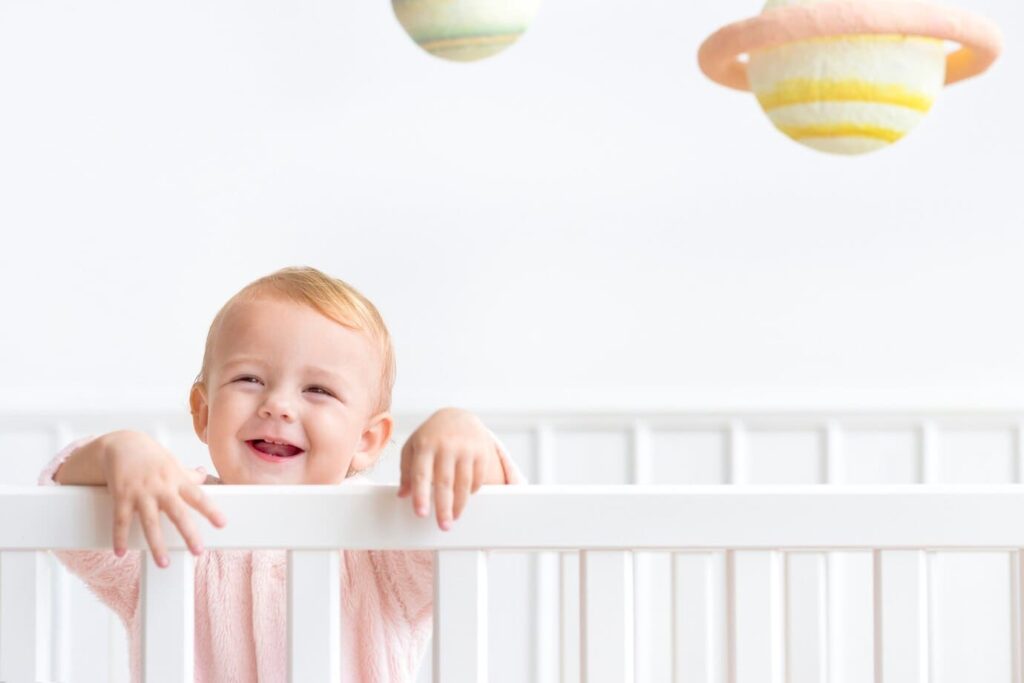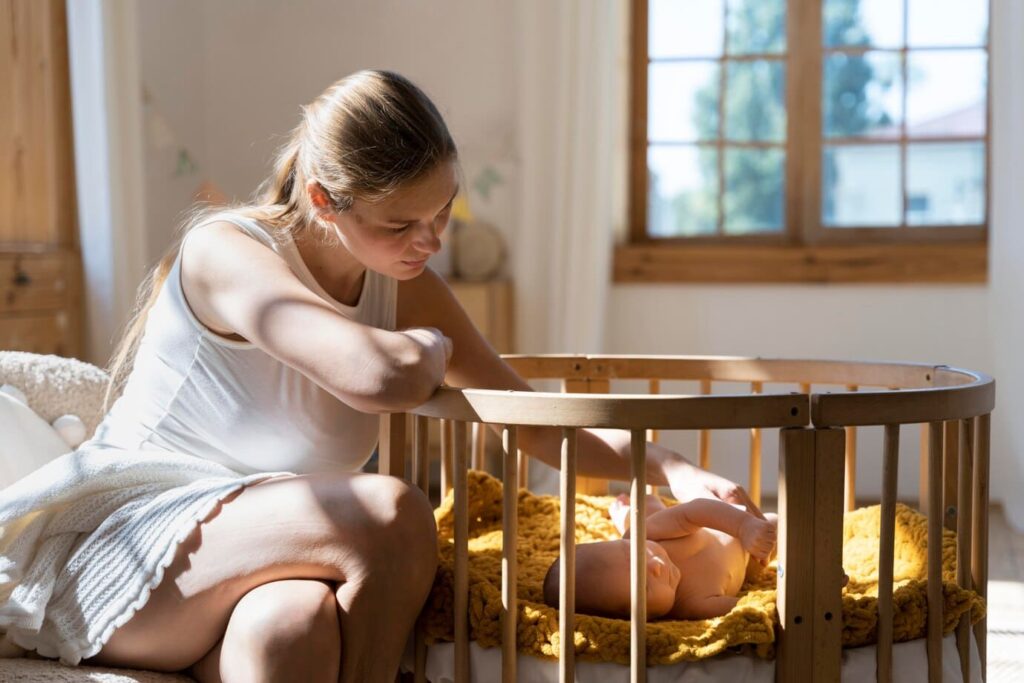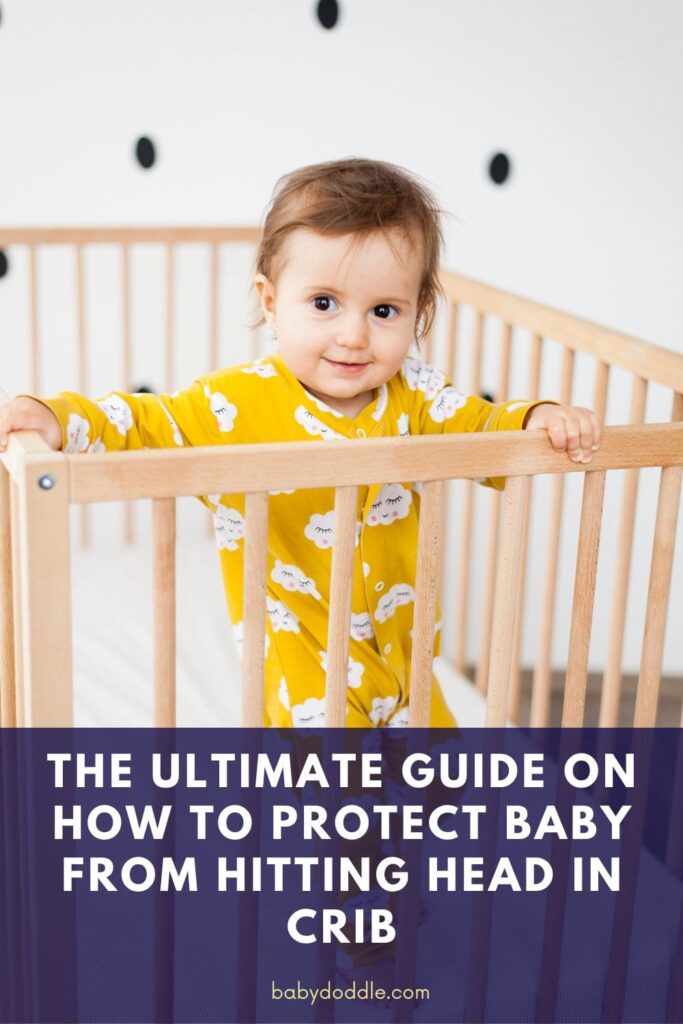As a parent, few things are more concerning than when your sweet little one starts hitting their head while in the crib. I know – I’ve been there! The crying, the worry that they seriously hurt themselves, wondering if you should call the doctor…it’s stressful.
But don’t panic! Head banging against the hard crib rails or slats is actually quite common and in most cases, it’s nothing to truly freak out about. Babies have resilient little noggins and bumps are part of the clumsy learning process as they figure out mobility in the early months. Of course, you still want to minimize it where possible and take reasonable precautions to promote safe sleeping through a variety of crib safety measures.
In this complete guide How to Protect Baby from Hitting Head in Crib, we’ll cover all aspects including:
- Why babies hit heads and what baby sleep concerns warrant worry
- Adjusting the crib setup for safety
- Selecting the right crib, mattress and bedding
- Alternate sleep space options
- Special baby crib accessories and bumpers to prevent head bonks
- What to do if baby gets injured
- And more helpful tips for crib safety!
Let’s get started with common reasons those little noggin knocks happen in the first place while baby sleep patterns are still erratic.

Why Babies Hit Their Heads in Cribs
Newborn sleep cycles definitely take some getting used to. And babies and toddlers bonk their heads constantly – while crawling, pulling up to stand, and clunking into furniture. So it follows that they’ll also bump foreheads on the hard crib parts at times too.
Here’s a few reasons this tends to happen:
- Developing mobility skills: From rolling over to scooting, sitting up and getting up on all fours, cribs provide the perfect enclosed place for little ones to practice new coordination abilities. And practice makes imperfect at first! Expect some tumbles.
- Limited space: Compared to free roaming the room, cribs are tight quarters. Less room to adjust means more bonks until baby masters the confined area.
- Poor balance and perception: An infant still developing hand-eye coordination and depth perception will wind up with some forehead knocks against rails or corner posts.
- Enthusiastic play: Some alert babies will get so revved up practicing their blossoming capabilities in the crib that flailing limbs lead to collisions with the hard pieces. Excitement over precision!
While startling in the moment, most of these head-meets-crib incidents are completely harmless events. If baby seems distressed, sore, or injured after a crib jolt, contact your pediatrician. But take comfort that early mobility mishaps simply indicate gradually sharpening movement mastery.
Now let’s look at adjusting the sleep area using some key crib safety practices to minimize rough crib encounters.
Baby Sleep Safety Tips For Protecting Baby’s Head In The Crib
While bumped heads from typical early baby mobility clumsiness shouldn’t spiral parental panic, you can take proactive measures to reduce them and protect your little sleeper using these crib safety adjustments:
Place Baby “Feet to Foot” In Crib
Aim baby’s feet to touch the end of the crib instead of their head being against the hard, flat wooden slats. This helps establish a sense of spatial boundaries from wall-to-wall in the small sleep space. Too much open crib space tempts scooting and rolling antics. Feet to foot restricts mobility urges while still allowing safe comfort.
Use Breathable Mesh Lining or Rail Guards
Gauzy mesh liners or padded rail guards prevent limbs from poking out between bars while allowing air flow for safe sleep breathing. They also cushion blows from reaching through the slats or rubbing against them. Physical separation plus minimal padding balanced with safety.
Bonus Tip: Check frequently that baby cannot grasp the mesh as a step to climb out as standing and cruising skills kick in.
Remove Mobiles and Toys During Sleep Time
It’s visually stimulating to have pretty danglies or soft shapes for awake baby playtime in the crib. But clear out extra loose attachments when napping or overnight to avoid accidental collisions, entanglements, or potential choking hazards. Don’t give baby something to hit their head on while floundering around the unsupervised crib in the dark.
Use Sleep Sacks/Wearable Blankets
Onesies, sleep sacks and wearable blankets prevent loose bedding from bunching or billowing around baby during sleep which could lead to overheating, face covering, or arm/leg insertion between crib bars. Well-fitted crib sheets also reduce loose wrinkling and extra safety suffocation risks.
Now that we’ve covered proactive crib setup adjustments for baby safety, let’s look closely at crib and mattress selection factors plus accessories.

Choosing The Right Crib, Mattress and Bedding
The crib, mattress and beddings themselves greatly impact safety. Follow these tips:
Select a Sturdy, Properly Sized Crib
The slats should be no more than 2 3/8 inches apart to avoid bodily protrusions. A snug mattress minimizes dangerous edge gaps small heads or limbs could slip into. Smooth, rigid sides prevent bodily damage and reduce footholds for climbing out.
Next Step: Once you’ve chosen a quality crib, take measurements and inspect the mattress shape matchup.
Use Snug Fitting, Firm Crib Mattress
Select a mattress where the edges precisely match up to the interior crib dimensions so gaps don’t form along the sides or corners. A firm surface prevents uneven sinking yet still supports delicate developing bones and joints for safe comfort.
Use Only Sheet Straps And Wearable Blankets For Bedding
Sheet straps prevent babies slipping under loose bedding while wearable blankets like baby sleep sacks maintain safe sleep positions along American Academy of Pediatrics guidelines up to baby’s first birthday.
There you have the essential protective equipment elements covered to support baby safety in the crib! Next let’s examine some alternate baby sleep transition options if injuries continue and accessories to prevent head bumps.
Alternate Sleep Spaces To Aid Crib Adjustment
If baby repeatedly hits their head or gets limbs stuck while floundering around in the crib, it may be time to try an interim sleeping solution before gradually transitioning back to the crib over time:
Use Pack ‘N Play Bassinets
Their cozy enclosed padded sides and reduced footprint limit the amount of tossing and turning allowing baby more restful sleep.
Next Step: If head banging and limb entanglements continue after a period back in the crib, try a floor mattress setup.
Use Floor Beds
A comfy crib mattress set directly on a soft rug removes falling hazards associated with standard beds and allows strengthened baby motor skill development freedom. Just be sure to completely baby proof and pad the room first!
We’ve covered protecting baby from injury risks within the crib itself and explored alternative sleep transition options. Now let’s examine useful crib accessories specifically designed to curb forehead knocks.
Crib Accessories That Help Prevent Baby Bumping Head
While not replacements for proper precautions, these additional crib tools help shield baby’s head during erratic sleeping movements:
Install Breathable Mesh Crib Liners
As mentioned before, mesh liners create a protective barricade between hard rails and little skulls all while avoiding suffocation dangers.
Use Crib Rail Pads
Like mesh liners, cushioned pads wrapped around hard rails soften incidental head bumps. They attach beneath fitted crib sheets to avoid detachment and potential choking threats if baby pulls them down.

Product recommendations
Keeping baby safe starts with having the right gear suited for each phase. Here are my top picks:
Cribs:
- DaVinci Jenny Lind 3-in-1 Convertible Crib
- Graco Benton 5-in-1 Convertible Crib
Crib Mattresses:
- Moonlight Slumber Little Dreamer
- Colgate Eco Classica III Dual Firmness
Mesh Liners & Rail Guards:
- BreathableBaby Mesh Crib Liner
- Dreambaby Chelsea Extra Tall Auto Close Gate
Creating a safe play zone around the crib
Make a protected play area right next to the crib during awake times:
Use baby gates to block access to danger zones in the room. Set up an enclosed play yard for mobile babies to explore safely.
Add thick foam floor tiles or alphabet play mats for soft landings.
What To Do If Your Baby Gets Hurt In The Crib
Despite preventative actions, babies will still bonk their heads occasionally. Usually it results in minimal bumps and baby recoups quickly. But monitor for:
- Visible bruising, cuts or bleeding
- Vomiting, extreme sleepiness – signs of concussion
- Won’t nurse or eat potentially signaling injury
- Excessive soreness or crying around a protruding bump
Call the pediatrician if health concerns arise regarding symptoms. Some visible marking is reasonable. But repetitive, uncontrolled, or unexplained head banging warrants medical guidance to rule out underlying issues.
Outside of that, try not to obsess over typical clumsy collisions. As alarming as the initial cries may be, remember – bumps signal emerging strength, mobility and resilience! Those early wins precede more graceful coordination.
Soothing techniques if baby hits head
Seeing your little one hit their head can be tough on both baby and parent! Try these soothing ideas:
Comfort baby with gentle hugs and sympathy. Speak softly and sweetly.
Let older babies self-soothe by giving them space to recover independently. Distract a fussy baby with songs, silly noises or a cool teething toy.
Detailed prevention tips for different baby development stages
As your baby grows and gains new abilities, the safety precautions you take will need to evolve as well. Here are some tailored tips for each stage:
| Age Range | Common Hazards |
|---|---|
| 0-3 months | Loose bedding near face, ill-fitted sheets, bunched mattress |
| 3-6 months | Mobiles/toys in reach, loose bumpers, blankets |
| 6-12 months | Crib climbers, loose crib parts used to hoist up |
| 12-24 months | Mesh liners enable climbing out, poor transitions to bed |
Newborn (0-3 months):
- Swaddle baby to restrict sudden movements that could lead to crib bumps
- Use a sleep positioner to keep them on their back if rolling over
- Keep the crib simple without loose parts during these early months
This section will be inserted after the paragraph beginning with “Place Baby “Feet to Foot” In Crib”.
Rolling Over (3-6 months):
- Lower the mattress to prevent falls as mobility increases
- Don’t use ill-fitting sheets that bundle up and lead to face-covering risks
- Add mesh liners once rolling begins so limbs don’t get stuck
| aby Weight | Mattress Height |
|---|---|
| under 35 lbs | highest level |
| 35 – 95 lbs | middle level |
| over 95 lbs | lowest level |
This section will be inserted after the paragraph beginning with “Remove Mobiles and Toys During Sleep Time”.
Pulling to Stand (6-12 months):
- Supervise all naps/sleep times to re-position baby safely
- Remove mobiles or toys in reach that could get pulled down
- Use a sleep sack instead of loose blankets that could strangle
This section will be inserted after the paragraph beginning with “Use Only Sheet Straps And Wearable Blankets For Bedding”.
Cruising and Climbing (12-24 months):
- Remove crib bumpers/mesh liners that can act as climb enablers
- Install an upside down crib during the transition period
- Gate the room to prevent free access/falls with newfound mobility
Final Thoughts On Protecting Baby From Hitting Head in Crib
While no caregiver enjoys seeing their little one bump their newly bald head, minor crib mishaps simply represent baby working hard to advance their movement abilities. Take sensible safeguards, watch for problematic symptoms…but also accept it as all part of the journey to dexterity.
Before you know it, those initial mobility mix-ups shift into freight train mobility no obstacle can impede! Until then, breathe easy and validate your parental protectiveness while reveling in your baby’s emerging durability. Their flexibility will delight you more and more.
Teaching baby safe mobility
Guide their blossoming coordination with patience and care:
Model gentle touch by stroking their arm when patting the crib.
If baby pulls up, firmly say “all done!” and lovingly sit them back down.
Place interesting toys across the crib so they learn to crawl safely within.
This section will be inserted after the paragraph beginning with “Final Thoughts On Protecting Baby From Hitting Head in Crib”
FAQs – How to Protect Baby from Hitting Head in Crib
Why do babies hit their heads in the crib?
Babies hit their heads in the crib as part of exploring mobility – rolling over, scooting around, sitting up, etc. Limited space and developing coordination also contribute. It’s very common and usually harmless.
What’s the best way to set up a crib to avoid head bumps?
Place baby “feet to foot” in the crib, use mesh liners or rail guards, remove loose toys/mobiles, use sleep sacks/wearable blankets instead of loose bedding, and ensure crib/mattress fit snugly without gaps.
Should I use crib bumpers if baby keeps hitting their head?
Only use breathable mesh bumpers if over 12 months old. Regular crib bumpers pose suffocation risks for young babies. Use caution and monitor closely as bumpers can become climbing aids out of the crib.
When should I worry about baby hitting their head in the crib?
Contact your pediatrician if you notice bleeding, bruising, cuts, vomiting, extreme sleepiness, unwillingness to eat, or excessive crying around a bump. Those signal potentially serious injury.
What alternate sleep spaces can I use if baby keeps hitting their head in the crib?
Try a pack ‘n play with padded raised sides or a crib mattress set on the floor temporarily if injuries persist in a standard crib. Transition baby slowly back to the crib over time.
What type of crib mattress is safest?
The safest crib mattresses are firm and flat to reduce the chances of baby getting limbs or head stuck in gaps. Look for solid mattresses made of polyurethane foam or plant-based materials that meet US safety standards. Avoid pillow-top or cushy mattresses that could pose suffocation risks.
When should I move the mattress to a lower level?
Lower the mattress height once baby can pull up on hands and knees or stand while holding the rails, typically around 6-12 months. This prevents injury from falling over the rails. Use the following rough guidelines based on weight:
- Highest level: under 35 lbs
- Middle level: 35-95 lbs
- Lowest level: over 95 lbs
Can I use curtains or canopy on my baby’s crib?
No, do not add any curtains, canopies or fabric overhangs to a crib as they pose serious suffocation and entanglement risks. Mesh liners or rail guards recommended instead allow airflow and visibility while protecting against knocks.
Is it safe for baby to sleep in a pack n’ play long term?
While convenient for travel, pack n’ plays should only be used temporarily for sleep at home, not as a permanent crib replacement after age 6 months. The thinner mattress and less air circulation could increase risks of overheating, breathing issues and head entrapment.
What should I look out for when borrowing a used crib?
Carefully inspect secondhand cribs for broken slats, protruding hardware and make sure paint isn’t chipping or peeling. Check assembly is stable, mattress fits snug with no gaps and relevant safety certifications are met. Vetting protects against unobserved wear. Replace old cribs.
Travel crib safety
On-the-go sleep spaces come with risks too so:
Choose a portable crib with mesh sides and firm mattress. Avoid flimsy blow up options.
Inspect hotel crib hardware, mattress fit and check for loose slats before use. Properly attach and lock the top before placing baby in pack ‘n plays.
| Safety Checks | Status |
|---|---|
| Mesh sides? | Yes/No |
| Firm mattress? | Yes/No |
| Mattress fits snug? | Yes/No |
| Locks securely? | Yes/No |
| Free of loose parts? | Yes/No |
Preparing home for next baby
Adding another sweetie to your home? Get their sleep space ready with:
A toddler bed transition to free up the crib again. Establishing crib safety standards that align across ages.
Vetting any handed down equipment thoroughly first.












